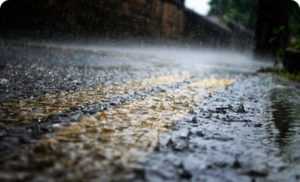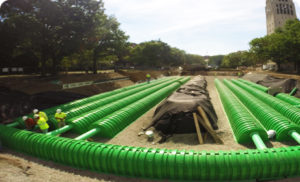
The objectives of storm water management include controlling stream and river bank erosion, improving water quality, and controlling flooding. To achieve these objectives, the volume, flow rate, and pollutant load of runoff leaving a site after development must be controlled. The U-M meets these objectives by building a coordinated network of structural and non-structural storm water control measures that work together to reduce, convey, and treat storm water runoff.
The University of Michigan is installing an underground storm water infiltration system on Central Campus this summer. This project will provide benefits to the environment, the university, and the city. U-M elected to install this infiltration system to reduce the likelihood of flooding, free up capacity in the university’s and City of Ann Arbor’s storm water systems, and protect the Huron River water quality.
The project is located under the lawn between State Street, Angell Hall and Tisch Hall, and Alumni Memorial Hall. Construction will begin shortly after commencement and is scheduled to be completed in fall 2018.
What and where:
- An underground storm water infiltration system will be constructed east of State Street under the lawn area west of Angell Hall and Alumni Memorial Hall.
- Buildings in this area have historically flooded when runoff overwhelms the Allen Creek Drain and associated City of Ann Arbor storm sewer system, which includes the storm sewer outlet for the university’s Diag storm water piping system.
- With this project, nine acres of storm water flow from the west side of the Diag will be redirected to the infiltration system.
This project is not required to meet any permit conditions. It is being installed electively to:
- Reduce the likelihood of flooding at Tisch Hall and other university infrastructure beyond a 100-year, 24-hour storm event
- Free up capacity in the university’s and City of Ann Arbor’s storm water systems
- Reduce flows to Allen Creek Drain
- Replenish groundwater
Benefits to city and community:
- Free up capacity in the City of Ann Arbor’s storm water system, which will reduce the likelihood of flooding
- Improve water quality by removing sediment and nutrients that would otherwise flow to the Huron River and ultimately Lake Erie
Basic info on how the infiltration system works:
- Water will flow through a sediment trap before reaching the basin. The basin will consist of concrete arches with a hollow bottom atop a gravel base that allows water to soak into the ground.
- The system can accommodate approximately 750,000 gallons of water at a time, which equates to 1.75 feet of water covering a football field.

U-M installed an underground infiltration basin in conjunction with a utility and hardscape upgrade project in Ingalls Mall just south of E. Washington Street. The basin location has well-draining sandy soil, which allows for complete infiltration of the 100-year, 24-hour design storm from the drainage area.
Project and construction information:
- The estimated cost of the project is $4,500,000. Funding will be provided from Utilities resources and investment proceeds.
- Construction will begin shortly after graduation and be completed in fall 2018.
- The project is phased to avoid interference with the State Street Art Fair.
- Although there will be a temporary loss of street parking spaces during construction, there will be no permanent impact on parking.
Related info:
- This project supports U-M’s campus sustainability goal to protect Huron River water quality by minimizing runoff from impervious surfaces.
- This elective project follows many others that U-M has completed as an added benefit the community, such as rain gardens, green roofs, porous surfaces, and infiltration or holding basins.

